2014 Peugeot 508 tow
[x] Cancel search: towPage 215 of 352
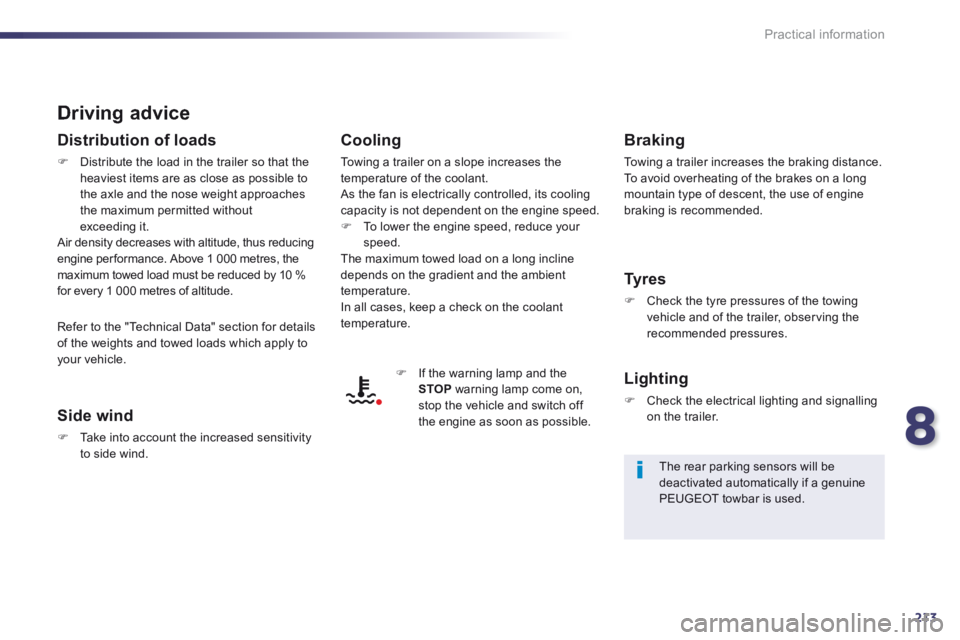
8
213
Practical information
Driving advice
Distribution of loads
Distribute the load in the trailer so that the heaviest items are as close as possible to the axle and the nose weight approaches the maximum permitted without
exceeding it. Air density decreases with altitude, thus reducing engine per formance. Above 1 000 metres, the maximum towed load must be reduced by 10 % for every 1 000 metres of altitude.
Side wind
Take into account the increased sensitivity to side wind.
Cooling
Towing a trailer on a slope increases the temperature of the coolant. As the fan is electrically controlled, its cooling capacity is not dependent on the engine speed.
To lower the engine speed, reduce your speed. The maximum towed load on a long incline depends on the gradient and the ambient temperature. In all cases, keep a check on the coolant temperature.
If the warning lamp and the STOP warning lamp come on, stop the vehicle and switch off the engine as soon as possible.
Braking
Towing a trailer increases the braking distance. To avoid overheating of the brakes on a long mountain type of descent, the use of engine braking is recommended.
Ty r e s
Check the tyre pressures of the towing vehicle and of the trailer, observing the recommended pressures.
Lighting
Check the electrical lighting and signalling on the trailer.
The rear parking sensors will be deactivated automatically if a genuine PEUGEOT towbar is used.
Refer to the "Technical Data" section for details of the weights and towed loads which apply to your vehicle.
Page 217 of 352
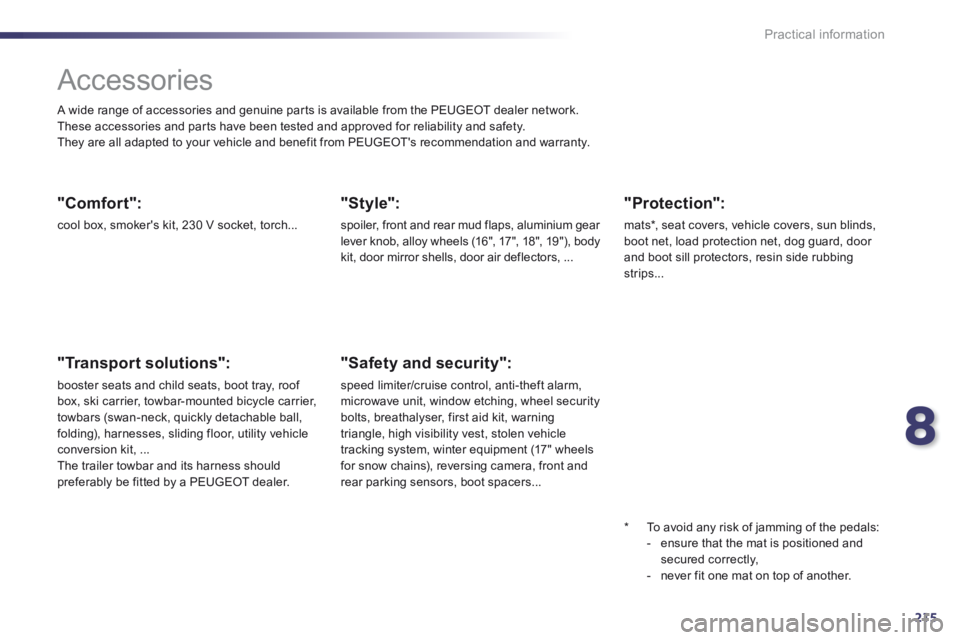
8
215
Practical information
Accessories
A wide range of accessories and genuine parts is available from the PEUGEOT dealer network. These accessories and parts have been tested and approved for reliability and safety. They are all adapted to your vehicle and benefit from PEUGEOT's recommendation and warranty.
"Comfort":
cool box, smoker's kit, 230 V socket, torch...
"Transport solutions":
booster seats and child seats, boot tray, roof box, ski carrier, towbar-mounted bicycle carrier, towbars (swan-neck, quickly detachable ball, folding), harnesses, sliding floor, utility vehicle conversion kit, ... The trailer towbar and its harness should preferably be fitted by a PEUGEOT dealer.
"Style":
spoiler, front and rear mud flaps, aluminium gear lever knob, alloy wheels (16", 17", 18", 19"), body kit, door mirror shells, door air deflectors, ...
* To avoid any risk of jamming of the pedals: - ensure that the mat is positioned and secured correctly, - never fit one mat on top of another.
"Safety and security":
speed limiter/cruise control, anti-theft alarm, microwave unit, window etching, wheel security bolts, breathalyser, first aid kit, warning triangle, high visibility vest, stolen vehicle tracking system, winter equipment (17" wheels for snow chains), reversing camera, front and rear parking sensors, boot spacers...
"Protection":
mats * , seat covers, vehicle covers, sun blinds, boot net, load protection net, dog guard, door and boot sill protectors, resin side rubbing strips...
Page 220 of 352
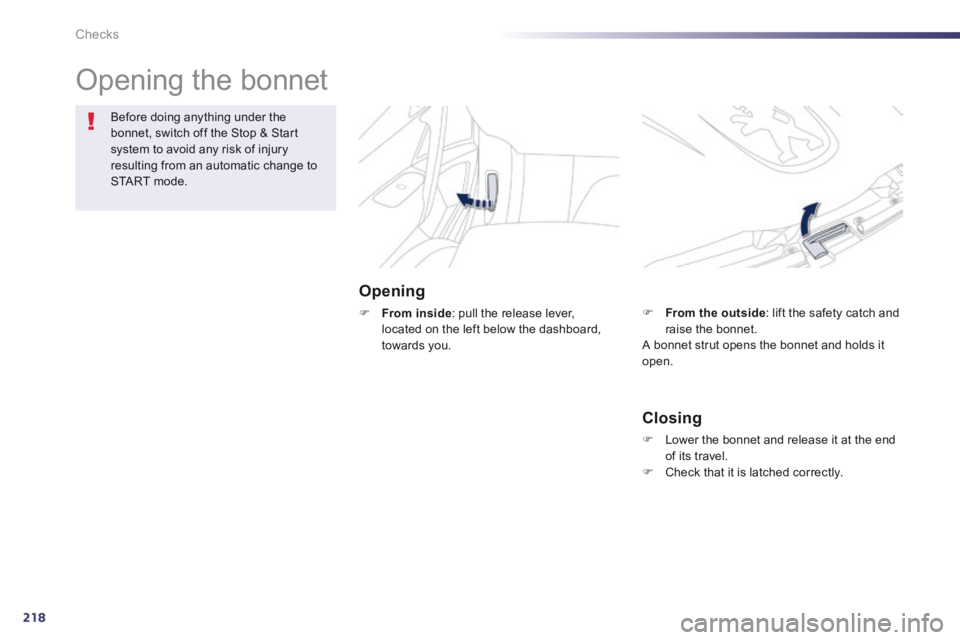
218
Checks
Opening the bonnet
Opening
From inside : pull the release lever, located on the left below the dashboard, towards you.
Before doing anything under the bonnet, switch off the Stop & Start system to avoid any risk of injury resulting from an automatic change to START mode.
Closing
Lower the bonnet and release it at the end of its travel. Check that it is latched correctly.
From the outside : lift the safety catch and raise the bonnet. A bonnet strut opens the bonnet and holds it open.
Page 231 of 352
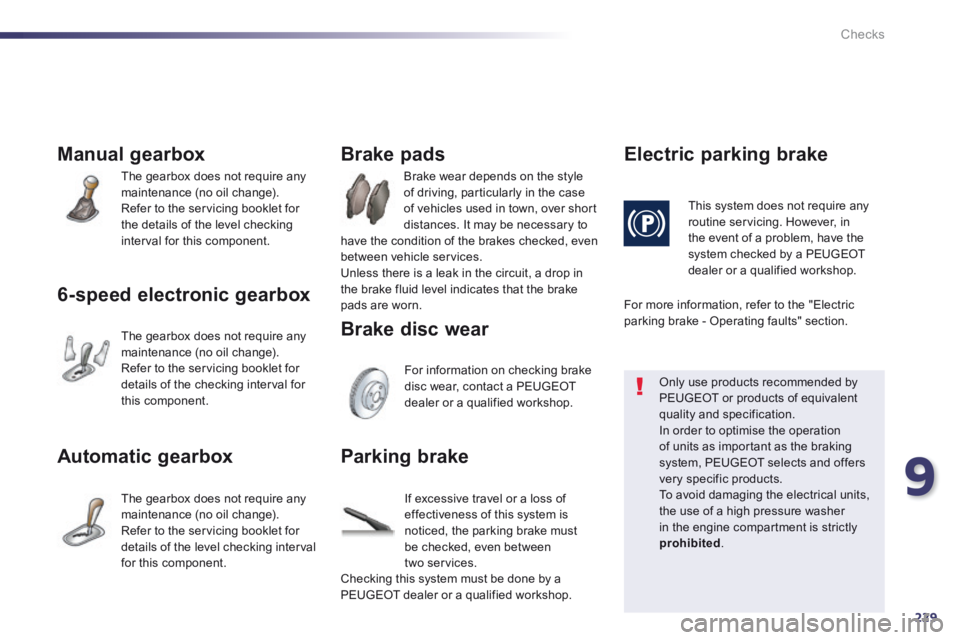
9
229
Checks
Manual gearbox
The gearbox does not require any maintenance (no oil change). Refer to the servicing booklet for the details of the level checking interval for this component.
6-speed electronic gearbox
The gearbox does not require any maintenance (no oil change). Refer to the servicing booklet for details of the checking interval for this component.
Automatic gearbox
The gearbox does not require any maintenance (no oil change). Refer to the servicing booklet for
details of the level checking interval for this component.
Brake wear depends on the style of driving, particularly in the case of vehicles used in town, over short distances. It may be necessary to have the condition of the brakes checked, even between vehicle services. Unless there is a leak in the circuit, a drop in the brake fluid level indicates that the brake pads are worn.
Brake pads
For information on checking brake disc wear, contact a PEUGEOT dealer or a qualified workshop.
Brake disc wear
Electric parking brake
This system does not require any routine servicing. However, in the event of a problem, have the system checked by a PEUGEOT dealer or a qualified workshop.
Only use products recommended by PEUGEOT or products of equivalent quality and specification.
In order to optimise the operation of units as important as the braking system, PEUGEOT selects and offers very specific products. To avoid damaging the electrical units, the use of a high pressure washer in the engine compartment is strictly prohibited .
Parking brake
If excessive travel or a loss of effectiveness of this system is noticed, the parking brake must
be checked, even between two services. Checking this system must be done by a PEUGEOT dealer or a qualified workshop.
For more information, refer to the "Electric parking brake - Operating faults" section.
Page 236 of 352
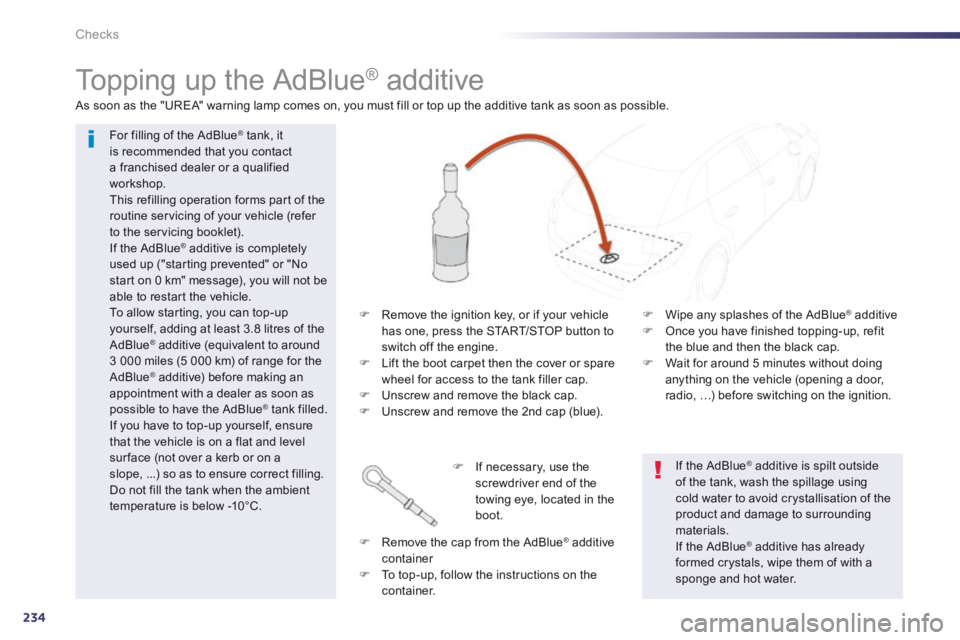
234
Checks
Topping up the AdBlue ® additive
For filling of the AdBlue ® tank, it ® tank, it ®
is recommended that you contact a franchised dealer or a qualified workshop. This refilling operation forms part of the routine servicing of your vehicle (refer to the servicing booklet). If the AdBlue ® additive is completely ® additive is completely ®
used up ("starting prevented" or "No start on 0 km" message), you will not be able to restart the vehicle. To allow starting, you can top-up yourself, adding at least 3.8 litres of the AdBlue ® additive (equivalent to around ® additive (equivalent to around ®
3 000 miles (5 000 km) of range for the AdBlue ® additive) before making an ® additive) before making an ®
appointment with a dealer as soon as possible to have the AdBlue ® tank filled. ® tank filled. ®
If you have to top-up yourself, ensure that the vehicle is on a flat and level sur face (not over a kerb or on a slope, ...) so as to ensure correct filling. Do not fill the tank when the ambient temperature is below -10°C.
As soon as the "UREA" warning lamp comes on, you must fill or top up the additive tank as soon as possible.
Remove the ignition key, or if your vehicle has one, press the START/STOP button to switch off the engine. Lift the boot carpet then the cover or spare wheel for access to the tank filler cap. Unscrew and remove the black cap. Unscrew and remove the 2nd cap (blue).
If necessary, use the screwdriver end of the towing eye, located in the boot.
Remove the cap from the AdBlue ® additive ® additive ®
container To top-up, follow the instructions on the
c o n t a i n e r.
If the AdBlue ® additive is spilt outside ® additive is spilt outside ®
of the tank, wash the spillage using cold water to avoid crystallisation of the product and damage to surrounding materials.
If the AdBlue ® additive has already ® additive has already ®
formed crystals, wipe them of with a sponge and hot water.
Wipe any splashes of the AdBlue ® additive ® additive ®
Once you have finished topping-up, refit the blue and then the black cap. Wait for around 5 minutes without doing anything on the vehicle (opening a door, radio, …) before switching on the ignition.
Page 238 of 352

236
Technical data
* The kerb weight is equal to the unladen weight + driver (75 kg). ** The weight of the braked trailer can be increased, within the GTW limit, if the GV W of the towing vehicle is reduced by an equal amount; warning, towing using a lightly loaded towing vehicle may have an adverse effect on its road holding.
Petrol weights and towed loads (in kg)
The GTW and towed load values indicated are valid up to a maximum altitude of 1 000 metres; the towed load mentioned must be reduced by 10 % for each additional 1 000 metres of altitude. The speed of a towing vehicle must not exceed 60 mph (100 km/h) (comply with the legislation in force in your country). High ambient temperatures may result in a reduction in the per formance of the vehicle to protect the engine; if the ambient temperature is above 37 °C, limit the towed load.
Petrol engines1.6 litre VTi 120 hp1.6 litre THP 15 6 hp
Gearboxes Electronic gear control (6-speed) Manual (6-speed) Automatic (6-speed)
Model codes 8D5FH8/P - 8E5FH8/P 8D5FS8/P - 8E5FS8/P 8D5FV8 - 8E5FV8 8D5FNA - 8E5FNA 8D5FVA - 8E5FVA
Body Saloon SW Saloon SW Saloon SW
- Unladen weight 1 390 1 410 1 400 1 420 1 410 1 430
- Kerb weight * 1 465 1 485 1 475 1 495 1 485 1 505
- Gross vehicle weight (GV W) 1 945 2 055 1 995 2 080 2 015 2 100
- Gross train weight (GTW) on a 12 % gradient 3 345 3 355 3 595 3 580 3 515 3 600
- Braked trailer (within GTW limit) on a 10 % or 12 % gradient 1 400 1 300 1 600 1 500 1 600 1 500
- Braked trailer ** (with load transfer within the GTW limit) 1 675 1 575 1 875 1 775 1 875 1 775
- Unbraked trailer 730 74 0 735 74 5 74 0 750
- Recommended nose weight 75 75
Page 239 of 352
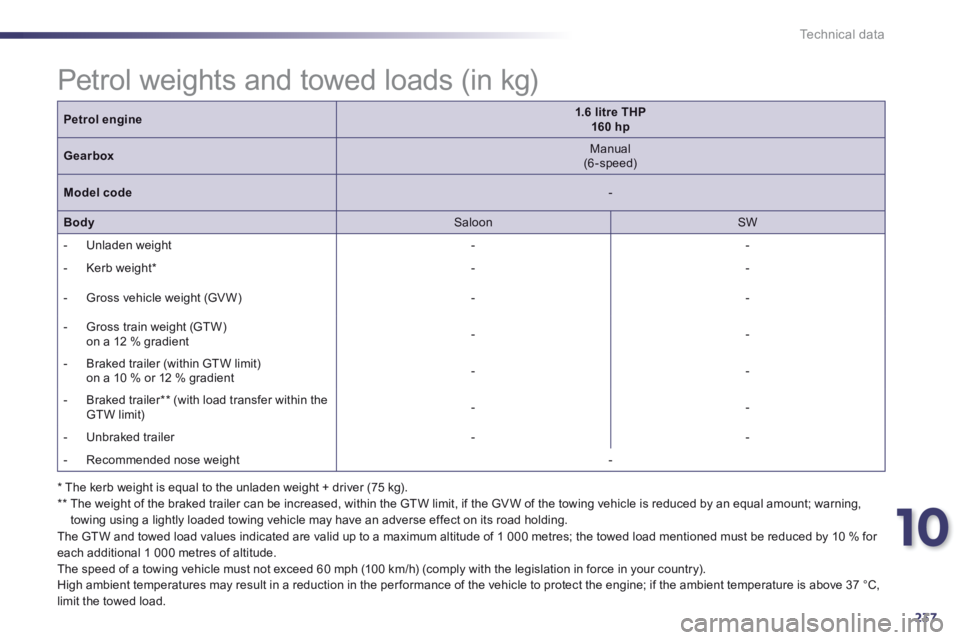
10
237
Technical data
Petrol engine1.6 litre THP 160 hp
Gearbox Manual (6-speed)
Model code -
Body Saloon SW
- Unladen weight - -
- Kerb weight * - -
- Gross vehicle weight (GV W) - -
- Gross train weight (GTW) on a 12 % gradient - -
- Braked trailer (within GTW limit) on a 10 % or 12 % gradient - -
- Braked trailer ** (with load transfer within the GTW limit) - -
- Unbraked trailer - -
- Recommended nose weight -
* The kerb weight is equal to the unladen weight + driver (75 kg). ** The weight of the braked trailer can be increased, within the GTW limit, if the GV W of the towing vehicle is reduced by an equal amount; warning, towing using a lightly loaded towing vehicle may have an adverse effect on its road holding.
Petrol weights and towed loads (in kg)
The GTW and towed load values indicated are valid up to a maximum altitude of 1 000 metres; the towed load mentioned must be reduced by 10 % for each additional 1 000 metres of altitude. The speed of a towing vehicle must not exceed 60 mph (100 km/h) (comply with the legislation in force in your country). High ambient temperatures may result in a reduction in the per formance of the vehicle to protect the engine; if the ambient temperature is above 37 °C, limit the towed load.
Page 244 of 352
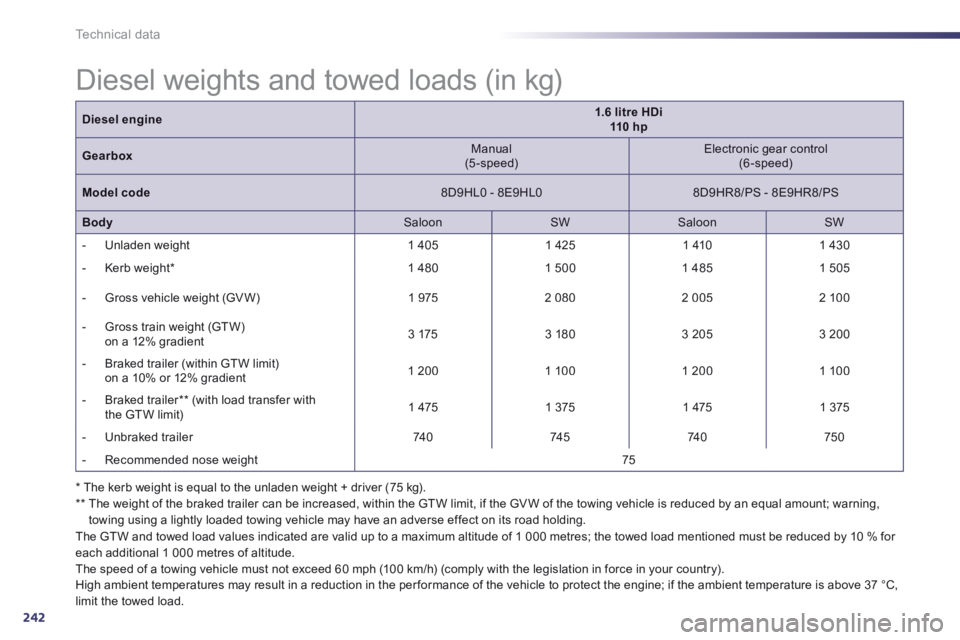
242
Technical data
* The kerb weight is equal to the unladen weight + driver (75 kg). ** The weight of the braked trailer can be increased, within the GTW limit, if the GV W of the towing vehicle is reduced by an equal amount; warning, towing using a lightly loaded towing vehicle may have an adverse effect on its road holding.
The GTW and towed load values indicated are valid up to a maximum altitude of 1 000 metres; the towed load mentioned must be reduced by 10 % for each additional 1 000 metres of altitude. The speed of a towing vehicle must not exceed 60 mph (100 km/h) (comply with the legislation in force in your country). High ambient temperatures may result in a reduction in the per formance of the vehicle to protect the engine; if the ambient temperature is above 37 °C, limit the towed load.
Diesel weights and towed loads (in kg)
Diesel engine1.6 litre HDi 110 h p
Gearbox Manual (5-speed) Electronic gear control (6-speed)
Model code 8D9HL0 - 8E9HL0 8D9HR8/PS - 8E9HR8/PS
Body Saloon SW Saloon SW
- Unladen weight 1 405 1 425 1 410 1 430
- Kerb weight * 1 480 1 500 1 485 1 505
- Gross vehicle weight (GV W) 1 975 2 080 2 005 2 100
- Gross train weight (GTW) on a 12% gradient 3 175 3 180 3 205 3 200
- Braked trailer (within GTW limit) on a 10% or 12% gradient 1 200 1 100 1 200 1 100
- Braked trailer ** (with load transfer with the GTW limit) 1 475 1 375 1 475 1 375
- Unbraked trailer 74 0 74 5 74 0 750
- Recommended nose weight 75